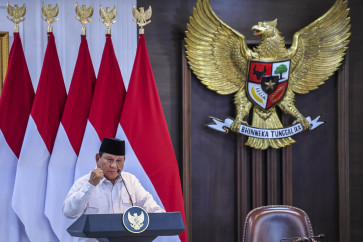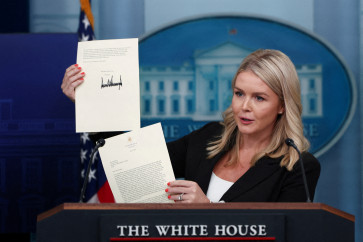Popular Reads
Top Results
Can't find what you're looking for?
View all search resultsPopular Reads
Top Results
Can't find what you're looking for?
View all search resultsSoeharsono: When smuggling becomes a public health issue
Soeharsono: JP/J
Change text size
Gift Premium Articles
to Anyone
Soeharsono: JP/J.B. Djwan
Veterinarian Soeharsono was enjoying life as a small animal vet in Denpasar until the recent outbreak of rabies in Bali shattered his calm.
For more than a quarter of a century, he hunted down the zoonotic diseases that make the leap from animals to humans – he knows how murderous they can be – at least six people have died in Bali from rabies since last November – and how simple to stop them dead in their tracks when everyone plays by the rules.
Trained at the world’s leading Centre for Tropical Veterinary Medicine in Edinburgh, Soeharsono spent his working life in animal disease diagnostics “basically I’m a lab man” at Bali’s Balai Penyidikan Penyakit Hewan Regional Denpasar (Denpasar Regional Animal Sickness Education Center) from 1975 until his retirement to his veterinary practice in 2001.
For much of that time, he called for stronger quarantine efforts to reduce the smuggling of dogs into formerly rabies-free Bali – his calls went unheeded and the disease has now claimed lives on the island of the gods.
His latest calls for long-acting rabies vaccines and “corridor” and “at risk” rabies control areas have also been ignored by government departments.
He said the decision by the Bali government to use an Indonesian manufactured rabies vaccine requiring a secondary vaccination just three months following the initial shot, with a third injection at 12 months, demands a doubling of manpower hours to immunize more than 20,000 dogs in the rabies-infected areas of Badung and South Denpasar.
The chances of locating all 20,000 dogs for revaccination are low, he said.“It’s impossible to revaccinate 20,000 plus dogs after three months. The second vaccine shot needed in the [rabies vaccination] regime may be halved – that’s my prediction.”
He added the initial vaccination of 20,000 dogs within the infected areas of Badung regency and South Denpasar may be addressing just the tip of the dog population iceberg, which, like the iceberg that sank the Titanic, could be massive.
“Some 20,000 dogs may be vaccinated, but the total population of dogs in the infected area is much higher than that – I feel that only 25 to 35 percent of dogs in the infected areas can be vaccinated. The problem is in the difficulty in catching the stray dogs. They are the major carriers – if we were using a 12-month-acting vaccine it would be much easier,” says Soeharsono.
The round of revaccinations is due to start on March 4.
Soeharsono has been at the forefront in the diagnosis of zoonotic or animal to human, disease transfer in Bali for several decades. During that period, he bore witness to the epidemic of rabies that washed across Flores between 1998 and 2003. The epidemic killed at least 113 people.
Smuggling three dogs from rabies-endemic Sulawesi into Flores was the time bomb that set off the Flores rabies disaster. Until that time Flores, like Bali until last year, was classified as rabies-free.
“This is critical – the weakness in rabies control is quarantine, animal quarantine. I lectured on this 25 years ago – I said it was only a matter of time, if dog smuggling continued, before rabies entered Bali,” he said of the laxity in the quarantine measures at Bali’s entry ports.
Quarantine breaches also occur with yachts or fishing boats arriving in other areas, such as Ungasan village, where the Bali rabies infection is believed to have begun.
Soeharsono is incredulous when he points out that even after the rabies outbreak, smugglers are still attempting to import dogs to the island.
“Almost 20 dogs were captured by the police at Gilimanuk quite recently – people are still smuggling dogs into Bali even now.”
This is where smuggling and possible corruption come into play as public heath issues.
Suddenly smugglers and those in office who turn a blind eye to their activities go from petty crime to manslaughter.
“This is a health issue when smuggled dogs get through [quarantine zones]. Vaccinations are being done, euthanasia is being done, but when smuggling continues – it is useless. The introduction of rabies [to Bali] is because someone smuggled a rabid dog into Bali,” which could not occur with tight quarantine controls, he says.
He points to the massive cost of addressing the damage done by one smuggler and one dog that may have, on a good day, returned just US$50 or over Rp 500,000.
“The massive cost of a rabies outbreak – and it takes just one dog – is an uncountable figure. But when it’s related to human life – in human terms this is an even greater cost,” he says.
Added to the criminal smuggling of dogs into Bali and its result in rabies and human deaths, is, he said, the government’s lack of foresight in effectively controlling the outbreak.
He cites specifically the Bali government’s decision to apply the three-month revaccination regime over the existing commercial vaccine that needs a booster at 12 months, allowing a much greater time-span to locate vaccinated animals and halving the frequency of vaccine application.
“The commercial vaccine is more cost and time effective. It is only around $1.50 per dose more expensive for the initial vaccine,”
The government-produced vaccine needs to be done twice over three months – virtually doubling the cost of the vaccine alone – that is not adding in the man-hours required explains Soeharsono, who joined many of Bali’s leading veterinarians at the head of the outbreak, calling for the use of the commercial vaccine based on scientific best practice and on public health needs.
The government also failed in its refusal to take on board the advice of professionals who, following the earliest rabies cases, called for immediate vaccinations in “at risk” districts bordering the initial outbreak area of Badung.
“We should be controlling rabies by vaccinating in the areas with infected dogs and the neighboring “at risk” areas. If you can control it in the “at risk” areas the disease will not spread. I recommended that plan of action at the meeting last December. The government at the time said it would focus on the areas with infected animals only. Within 10 days the disease had spread into neighboring districts,” says Soeharsono, of the inadequate science applied to controlling the rabies outbreak.
He points out that movement of dogs – particularly strays – is high. Nearby areas not yet within the government’s vaccination zone are currently at risk, he explained.
“Gianyar is very close to Sanur – if the dogs travel along the beach from Sanur to, say, Ketewel in Gianyar and then move inland …,” he says of what he classifies as “corridor” zones where dogs also need vaccinations. With manpower tied up revaccinating around 20,000 dogs, resources are stretched to the limit.
“The best solution to rabies throughout Indonesia is the oral [rabies] vaccine. It can be thrown out as baited meat across the country – this is used in France to control rabies in foxes. This is the best solution because you can reach stray dogs – that are almost impossible to catch and very dangerous.”










